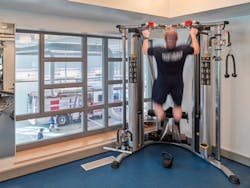High-Intensity Functional Fitness is Best for Firefighters
The responsibilities in a firefighter's line of work include many dangerous situations. Racing towards a raging fire rather than away from it takes some serious mental fortitude. It also requires a threshold of physical fitness.
According to Current Sports Medicine Reports, it is not unusual for firefighters to encounter "toxic fumes, dangerous combustion products, high radiant heat loads" amid chaotic and stressful environments.1
To perform the job of a firefighter well, "high levels of aerobic fitness, anaerobic capacity, and muscular strength and endurance" are essential. Body composition, aerobic capacity, and muscular power, strength, and endurance significantly improve at a firefighter training academy. However, many of those gains are lost once recruits finish their probationary period as active-duty firefighters.2 This signals a need for active-duty firefighters to find feasible training programs to acquire and maintain the physical fitness needed to carry out their essential work effectively.
Let's cover some of the best and most time-efficient options in the gym to improve firefighters' five critical fitness areas listed above.
Body Composition and Aerobic Capacity
It may not seem like body composition—measured by body mass index (BMI), body adiposity index (BAI), body fat percentage, and waist circumference—is vital for firefighters, but cardiorespiratory fitness certainly is. Poor body composition is correlated to obesity, which is associated with decreased cardiorespiratory fitness.
Training in the gym can enable firefighters to respond more adequately to high-stress situations where peoples' lives are potentially at stake. Exercise significantly improves cardiorespiratory fitness, but not all training is created equal.
Total body training has been shown to improve maximal strength gains. Training splits stimulate muscle growth.5 Depending on a firefighter's schedule, either total body training or training splits can prove effective for body composition and, therefore, cardiorespiratory fitness.
Intensity is Key
Bill Grundler, a retired captain with CAL FIRE's San Luis Obispo Unit and the SLO County Fire Physical Fitness Coordinator, believes firefighters "need to train their body as a system, using strength training, conditioning, and gymnastics at a high level of intensity." Low-impact training of leisurely cardio and light-weight work is "not going cut it."
“Many make the mistake of...doing long slow duration training...it will NOT prepare you. This doesn't help in an emergency,” he said.
As the owner of CrossFit Inferno in San Luis Obispo County, Grundler recommends the constantly varied functional fitness of CrossFit® training for firefighters.
“There isn't anything that fit the needs of these jobs [better] than CrossFit.”
Grundler believes CrossFit training's constant variance of functional movements performed at high intensity "mimics movements in the field." Compelling the body to move as a "system" rather than focusing on individual muscle groups. Single-joint exercises like leg extensions or biceps curls are still valuable tools to turn to now and then in training, but when training for the job of a firefighter, intensity is key.
The science appears to support Grundler's assertions. Physiological Reports found that high-intensity resistance training leads to greater strength and hypertrophy gains during short-term training than just high volume.6
High-intensity training also proved more fruitful for improving isometric force and rate of force development—valuable assets when moving ladders, hoses, and other implements during emergencies.7 Additionally, training at higher intensity can lead to a lowered risk of heart disease, and "as exercise training intensity rises, so may the magnitude of improvement in quality of life."8
Muscular Power, Strength, & Endurance
Grundler boils down the requisite movements firefighters should perform in the gym to fundamental lifts: deadlifts, cleans, presses, pull-ups, burpees, and squats. The implements used, be they barbells, dumbbells, kettlebells, or the like, are less important than ensuring the lifts go heavy.
“Think about moving a victim or your partner with their gear on,” he said.
A complete workout for a firefighter should include three parts: a short section that lasts up to 10 minutes, a moderate section that lasts up to 25 minutes, and a long section that is 30 minutes or more. Theoretically, a full workout for a firefighter could be completed within an hour. Below are five workouts, each with a short strength section, a moderate, and a long section that Grundler recommends for firefighters.
Workout One
Strength Section
10-minute EMOM (every minute on the minute) — bench press threes:
Minute One — 3 reps at 55 percent of max bench press
Minute Two — 3 reps at 65 percent of max bench press
Minute Three — 3 reps at 75 percent of max bench press
Minutes Four through 10 — 3 reps at 85 percent of max bench press
Metcon Section
Three rounds for 16 minutes total of the following four-minute AMRAP (as many rounds as possible):
30 seconds of cleans for max reps — Men: 135 pounds | Women: 95 pounds | or 45 percent of max weight clean
30 seconds of bar-face burpees (BFB) for max reps*
Two-minute rest
*BFBs involve performing a burpee facing a barbell on the ground in front of you, then jumping over the barbell, turning around, and performing another burpee. Repeat for 30 seconds.
Long Section
Minimum 30 minutes of:
Step-ups on a 20-inch box with a 50-pound weighted vest or barbell
Workout Two
Strength Section
Two rounds of back squats:
7 reps at 60 percent of max back squat
5 reps at 70 percent of max back squat
3 reps at 80 percent of max back squat
3 reps at 85 percent of max back squat
Metcon Section
10-minute AMRAP:
20 wall balls — Men: 20 pounds | Women: 14 pounds
60 double-unders or lateral hops
Long Section
250-meter swim (warm-up)
10 100-meter swims — 1:1 work:rest ratio
250-meter swim (cooldown)
Workout Three
Mixed Section
24-minute EMOM:
Minute one: 100-meter run
Minute two: 20 pull-ups
Minute three: 10 deadlifts — Men: 275 pounds | Women: 195 pounds | or 60 percent of max deadlift
Minute four: 20 ring dips or hand-release push-ups
Long Section
Minimum 30 minutes of:
Partner Carry:
400-meter partner carry*
*Each person must carry their partner 400 meters before switching places.
Workout Four
Strength Section
Push Presses with a 12-minute time cap:
Three-minute EMOM: 4 reps at 75 percent of max push press
Three-minute EMOM: 3 reps at 80 percent of max push press
Three-minute EMOM: 2 reps at 85 percent of max push press
Three-minute EMOM: 1 rep at 90 percent of max push press
Metcon Section
15-minute time cap of the following:
Six-minute AMRAP:
10 alternating dumbbell snatches — Men: 70 pounds | Women: 50 pounds
10 thrusters: Men — 95 pounds| Women: 65 pounds
Three-minute rest.
Six-minute AMRAP:
10 alternating dumbbell snatches — Men: 50 pounds | Women: 35 pounds
10 thrusters — Men: 75 pounds| Women: 55 pounds
Long Section
20 minutes of:
20 seconds for max calories
40 seconds easy ride
Score yourself by total calories.
Workout Five
Strength Section
10 sets of three deadlifts to establish three-rep max:
Sets 1-5 — light and building
Sets 6-10 — heavy working sets
Metcon Section
Four rounds of the following:
500-meter row
Four-minute AMRAP of each of the following:
Max kettlebell swing — Men: 70 pounds | Women: 53 pounds
Max alternating dumbbell hang clean & jerks — (70/50)
Max kettlebell sumo deadlift high-pulls — Men: 70 pounds | Women: 53 pounds
Max burpees over the rower
Two minutes rest.
Long Section
Five-kilometer run on a treadmill at a high incline of choice
Fire and Fitness
There is no doubt that exceptional physical fitness is needed to perform the valiant and essential work of a firefighter. The science suggests high-intensity functional fitness training is not only the most efficient option, but the optimal choice for improving the areas of fitness firefighters should prioritize. Training for cardiorespiratory and muscular endurance, force development, and a readiness for unexpected variables will keep you fighting fires effectively over the long term.
References
Smith D. L. (2011). Firefighter fitness: improving performance and preventing injuries and fatalities. Current sports medicine reports, 10(3), 167–172. https://doi.org/10.1249/JSR.0b013e31821a9fec
Cornell, D. J., Gnacinski, S. L., Meyer, B. B., & Ebersole, K. T. (2017). Changes in Health and Fitness in Firefighter Recruits: An Observational Cohort Study. Medicine and science in sports and exercise, 49(11), 2223–2233. https://doi.org/10.1249/MSS.0000000000001356
Nogueira, E. C., Porto, L. G., Nogueira, R. M., Martins, W. R., Fonseca, R. M., Lunardi, C. C., & de Oliveira, R. J. (2016). Body Composition is Strongly Associated With Cardiorespiratory Fitness in a Large Brazilian Military Firefighter Cohort: The Brazilian Firefighters Study. Journal of strength and conditioning research, 30(1), 33–38. https://doi.org/10.1519/JSC.0000000000001039
Lin, X., Zhang, X., Guo, J., Roberts, C. K., McKenzie, S., Wu, W. C., Liu, S., & Song, Y. (2015). Effects of Exercise Training on Cardiorespiratory Fitness and Biomarkers of Cardiometabolic Health: A Systematic Review and Meta-Analysis of Randomized Controlled Trials. Journal of the American Heart Association, 4(7), e002014. https://doi.org/10.1161/JAHA.115.002014
Bartolomei, S., Nigro, F., Malagoli Lanzoni, I., Masina, F., Di Michele, R., & Hoffman, J. R. (2021). A Comparison Between Total Body and Split Routine Resistance Training Programs in Trained Men. Journal of strength and conditioning research, 35(6), 1520–1526. https://doi.org/10.1519/JSC.0000000000003573
Mangine, G. T., Hoffman, J. R., Gonzalez, A. M., Townsend, J. R., Wells, A. J., Jajtner, A. R., Beyer, K. S., Boone, C. H., Miramonti, A. A., Wang, R., LaMonica, M. B., Fukuda, D. H., Ratamess, N. A., & Stout, J. R. (2015). The effect of training volume and intensity on improvements in muscular strength and size in resistance-trained men. Physiological reports, 3(8), e12472. https://doi.org/10.14814/phy2.12472
Mangine, G. T., Hoffman, J. R., Wang, R., Gonzalez, A. M., Townsend, J. R., Wells, A. J., Jajtner, A. R., Beyer, K. S., Boone, C. H., Miramonti, A. A., LaMonica, M. B., Fukuda, D. H., Ratamess, N. A., & Stout, J. R. (2016). Resistance training intensity and volume affect changes in rate of force development in resistance-trained men. European journal of applied physiology, 116(11-12), 2367–2374. https://doi.org/10.1007/s00421-016-3488-6
Ostman, C., Jewiss, D., & Smart, N. A. (2017). The Effect of Exercise Training Intensity on Quality of Life in Heart Failure Patients: A Systematic Review and Meta-Analysis. Cardiology, 136(2), 79–89. https://doi.org/10.1159/000448088

Phil Blechman
Phil Blechman is an editor for BarBend.com, which covers a wide range of topics in strength, including training, nutrition, sports, news, analysis, reviews, and opinion.
Phil is a native New Yorker passionate about storytelling, bodybuilding, and game design. He holds a BFA from Syracuse University.






